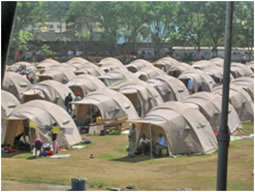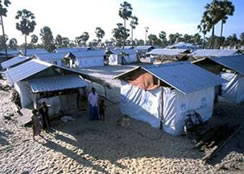Why the HOME Shelter? |
| The HOME Shelter is an acronym. The letters HOME stand for Human Occupied Modular Emergency. The word 'Shelter' completes the acronym which really spells out HOMES. |
|
| There are 3 types of shelter for refugees and Internally Displaced People (IDPs). IDPs are people displaced from their residence but living within the geographical borders of their home state. |
| |
| Tent shelters are the ‘first responder’ emergency shelter. Easy to set up within days after the disaster. Large tent cities take weeks and months to set up on level areas outside the disaster area. Tent cities provide shelter for tens of thousands of people. But they are short term solutions since the material is shredded by wind; UV light destroys the fabric within a year or so. |
| |
| Transitional shelter is established usually months or years later after negotiations with governments, land owners, and agencies. Transitional shelter is usually a rigid roof structure with fabric or low solid walls. While many are constructed with local materials, such as wood, sandbags, metal sheeting, commercial shelters are available. They are usually much larger than emergency shelter and can require manual or power tools to set up and tear down. They can take a day or more to build. Some require heavy machinery (i.e., forklifts and frontloaders) to emplace and contain loose parts (bolts, panels, tubes, windows, fasteners). They can require many trained personnel to assemble and use complex instruction manuals. |
| |
| Permanent shelter has rigid walls and roofs, windows and doors, separate interior rooms, and conveniences like toilets. |
| |
| |



